The Pyrex "Knob Top"
by Dan Wagner
Reprinted from "Crown Jewels of the Wire", November 1987, page 7
What is the first thing that someone says to you when you show them a
"new find" insulator? It usually goes something like this. "Wow!
That's really neat! Where did you get it?" This sure has been happening to
me lately. Before I tell how I found this insulator, I would like to give you a
brief history about how I got started in insulator collecting. Since this is the
first article I have written for CROWN JEWELS OF THE WIRE, I am sure there are a
lot of collectors out there who know little about me and have not met me.
It all started in the late 1960's. I was a young teen on my bicycle riding
along an abandoned railroad line on the northwest edge of Omaha. This was part
of the Chicago and Northwestern system. After several years of collecting
insulators while riding my bike, I discovered CROWN JEWELS OF THE WIRE through
another young collector that I had met along the way. My first issue was August,
1972. After reading my first issue, I quickly located about a year's worth of
back copies to get a little more educated about the hobby. Then came the shows.
Oh, what a fantastic time shows were. People would bring in "new
finds" at almost every show. Things that no one had ever seen before. It
was very exciting! I am really glad that I had an opportunity to experience
those early shows in the hobby.
It wasn't easy for me to get to shows since I was not old enough to drive. My
older sister was good to me and took me to a few of them. We drove to Auburn,
Nebraska, and to Denison, Iowa. I can remember March 31, 1973, when I attended a
swap meet in Denison which was put on by Warren Olson. I can remember meeting
Dennis McHenry who still remains a good friend. I arrived home that evening to
the news that my father had passed away after a long battle of several years
with cancer. Somehow the good time I had at the swap meet lessened the pain of
that kind of news.
When I was old enough to drive, I attended the shows at Hutchinson, Kansas.
This was a hot spot during this time period. Not too long after that I sold out
of the hobby at a show in North Kansas City on September 14, 1974. This began a
6-1/2 year absence from the hobby. Then one day, in the winter of 1980-81, I was
looking through my back issues of CROWN JEWELS OF THE WIRE, which I had kept
along with a few insulators. I decided to call Dora to see if the hobby was
still kicking. This was when I got back into the hobby and my first issue (this
time) was February, 1981.
During the early years in the hobby I was a specialist in PYREX insulators,
although I was not able to complete a set of all known PYREX CDs. I immediately
made this a goal when I re-entered the hobby. This is a difficult task, for
there are only 2 known CD 328's and only about 5 known CD 330's. I have been
very fortunate to locate both. When I bought a copy of the Milholland
Bicentennial Edition book, I noticed that there had been a lot of changes from
the old 1972 book I had used in my early days of collecting. It was this new
copy of the Milholland book that helped me locate the new insulator pictured on
the front cover.
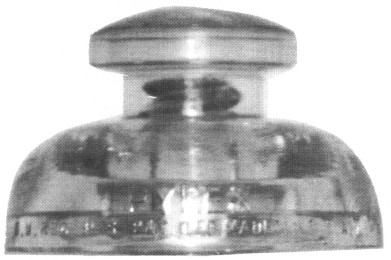
(Above and below - November cover photos)
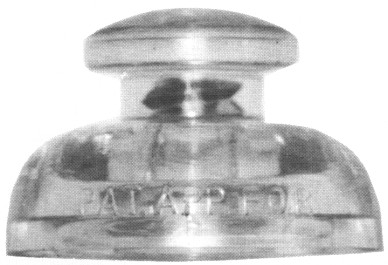
If you take a look on page 319 of the Milholland "MOST ABOUT GLASS
INSULATORS, Bicentennial Edition", you will find the listing of a CD 287
PYREX. Under the listing is the name of Dorothy and Frank Prinzinger of
Douglasville, Pennsylvania. One day in early 1981, I picked up the phone and
checked to see if they had a phone listed. This began several years of
negotiations. It is obvious that this insulator is not a CD 287. While talking
to Mr. Prinzinger I told him about this listing. His only Milholland book was
the one from 1972, so he was totally unaware that there was a listing in the
1976 edition.
How did the Milhollands know about the insulator? Mr. Prinzinger said he had
shown it to the Milhollands at a show about 1972. He couldn't remember the time
or the place for sure, but for some reason it ended up being listed as a CD 287.
Frank says he found this insulator at a flea market in Collegeville,
Pennsylvania in the summer of 1971. Sixteen years have come and gone, but I
would suggest that collectors watch for a similar insulator when in that area.
On page 26 of the April, 1972 issue of CROWN JEWELS OF THE WIRE, you will
find a short letter from Frank Prinzinger about the piece which he nicknamed
"The Knob Top." The really intriguing thing about this insulator is
the fact that it has a 5/8" pinhole and a triple petticoat. This is hard to
figure out. Could it be a carrier? Possibly, but the skirts on carriers are
usually narrow. The drawing that I made shows some detailed dimensions.
Now let's get to the color of the insulator. It is a light carnival coating
with the inside of the pinhole being slightly darker. It has been known for a
long time that carnival on power pieces that Corning produced were strictly for
use as a "marking device." No carrier PYREX has been found in carnival
to my knowledge. The following is some interesting information that comes from a
small publication put out by Corning Glass Works. The publication is titled
"PYREX Sand & Imagination." The article is entitled "An
Electronic Overcoat."
It was a warm spring evening in May, 1927. A man and his wife sat in living
room chairs listening intently to the tiny voice of a radio
announcer..."Ladies and gentlemen, the news. Charles Lindbergh today became
the first man to..." BUZZ! SQUAWK! "...landed near Paris after a
flight of less than 34 hours over..." HUM! BUZZ! The roar of static rose to
a painful din. The man snapped off the radio in disgust.
The static that plagued
the youthful radio industry became Corning's problem in 1926 when glass
insulators began to replace porcelain on telephone and power lines. For the
solution, scientists developed a process which led to entirely new uses for
glass.
In 1926, Corning began producing glass insulators for phone and power lines
and soon was faced with the problem of radio static. Investigation by Dr.
Littleton and Dr. Shaver showed that the radio noise was caused by a build-up of
high voltage electricity on the insulators. When the power reached a peak, it
discharged. Like natural lightning, it created radio static.
On the basis of Littleton's earlier studies, a conductive coating of tin
oxide was tried. The two scientists found that it allowed electricity to leak
noiselessly off the insulators. By 1928, Corning was producing insulators with
an electronic overcoat and radio audiences found the listening better.
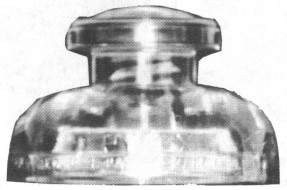
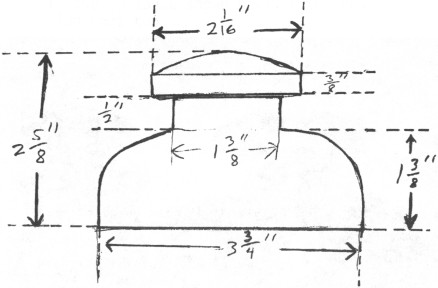
| Embossing: |
| Front - |
PYREX
T.M. REG. U.S. PAT. OFF. MADE IN U.S.A.
|
| Back - |
PAT. APP. FOR |
| Color: Lt. carnival
Pinhole: 5/8"
Triple Petticoat |
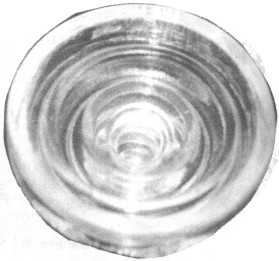 |
This article may relate to this insulator. It is only speculation. I would
also like to share with you the information sent to me by Mr. N.R. Woodward upon
his inspection of the insulator.
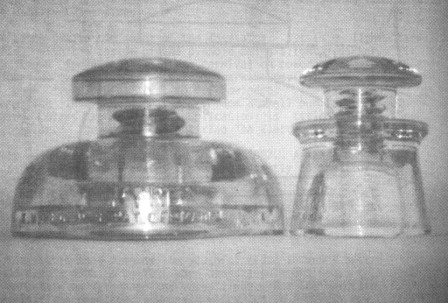
The Pyrex Knob Top next to a CD 100.5
Pyrex unit for size comparison.
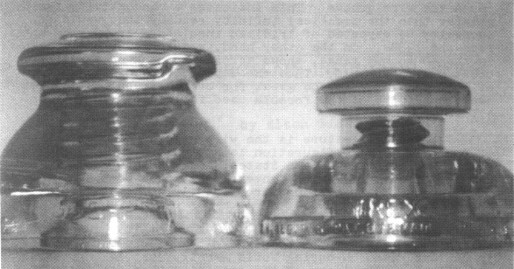
On the left is a super rare Pyrex which is the CD 139.6 shown
next to the new find knob top.
|
P. O. Box 171
Houston, TX 77001
July 18, 1987
Mr. Dan Wagner
12930 Ames Avenue
Omaha, NE 68l64
Dear Mr. Wagner:
Sorry to be so slow in getting back to you regarding the Pyrex piece
you sent to Marilyn Albers for drawing and evaluation.
This item is truly a mystery. It does not fit in anywhere. The design
is that of a high tension insulator; but the pin hole corresponds to those
used in carrier insulators for communication work at high frequencies.
The primary feature of carrier insulator design is the narrow skirt.
All carrier styles were manufactured with a minimum skirt diameter
consistent with mechanical requirements in line construction. This feature
relates to leakage characteristics, as opposed to flash-over
characteristics. The latter involves the flared skirt and is of no concern
in communication work.
Another question involves the iridescent coating. We do get a very high
resistance reading, in the 100K area, across the wire groove. This
indicates a conductivity far greater than the practical infinity reading
that would of necessity be expected of iridized insulators as we know them
from the 1930s. On the other hand, a much lower resistance, in the 40 to
60K range, shows across the neck of a radio-treated Kimble - 830. Thus the
conductivity of the surface of your insulator is too great for ordinary
application but seems not to be of the formula used for radio treatment
either.
Yet another feature is the wire groove. A side groove of that size and
configuration is not suitable for any high voltage work in the United
States, and making a typical AT&T carrier circuit tie using
conventional tools would be well-nigh impossible in that posture directly
above a sharply flared skirt.
My best guess is that you have a specialty piece that was designed for
support of high voltage equipment, possibly in nuclear research during
World War II, just as a guess. The slight conductivity of the iridizing
used may indicate that a flash-over was in fact desired in event of
excessive applied voltage. Mind, this is just a wild guess. At this point,
though, it seems quite certain the piece was not designed as a line
insulator.
Thank you again for sending this most interesting acquisition! Since we
only assign CD numbers to bona fide line insulators that were produced in
at least sufficient quantities for commercial line tests, I won't be able
to give a number. It doesn't fit any classification that we have!
Very truly,
N. R. Woodward
|
My PYREX collection has come a long way from that first PYREX CD 128 I found
in the late 1960's. I still have that insulator today. My interest in PYREX has
continued and I would like to write articles on the PYREX family in future
issues. I welcome any comments about my "New Find" or any other PYREX
insulator.
Thanks to Carol McDougald and her brother, Dave Magill, for picking up the
insulator from Mr. Prinzinger in Pennsylvania and shipping it safely to its home
here in Omaha.
DAN WAGNER, 12930 Ames Avenue, Omaha, NE 68164
| 